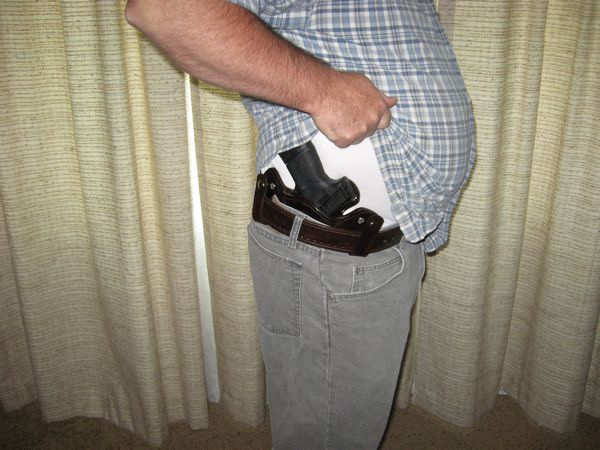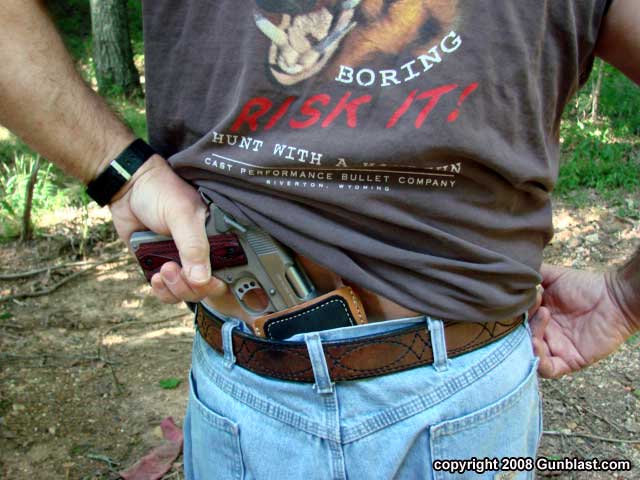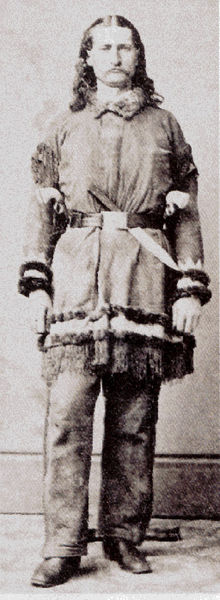- Appendix
- Strong side hip

- Strong side kidney

- Small of the back

- cross carry
You want to keep printing to a minimum, because, after all, you don't want the people around you to know you are packing heat. That will give you attention you don't want, more often than not, from the police.
Appendix Carry
This carry position has the pistol sitting in the front of the hip on the strong side. Since most people are right handed, it is called the appendix carry. The position of the pistol is straight up and down. The draw for this position is done, just like this:Advantages:
- Speed
- No printing, full range of movement allowed.
- Ease of movement in a struggle, the large muscles of the upper body are used to draw
- Unless somebody grabs your junk, you don't have to worry about people stealing your pistol unbeknownst to you.
- There is no need to protect your hips or make socially awkward movements to avoid people bumping in to your gun.
- The business end of the pistol is very near what makes a man a man... Negligent discharge may emasculate you.
- Pistol can not be drawn from a seated position.
- Pistol can only be drawn when the upper body is moved upright relative to the waist.
- Full size pistols are difficult to conceal.
- Extra magazines must be stored elsewhere.
This is the method that I use when I am using on the body carry. I believe it offers the greatest amount of flexibility, without sacrificing wardrobe or movement.
One major disadvantage is that you have to either stand all the way up, or lay all the way down in order to draw the pistol. If you are in a crouch taking cover, you can't get to your pistol, with out exposing yourself to fire.
Strong Side Hip Carry
This is the most common form of carry. Pistol is right there on your hip, with the cant, or angle, of the holster again at neutral, or straight up and down. Draw:Advantages:
- Natural draw movement
- Drawing from a seated position is awkward, but possible.
- Very comfortable carry position.
- A negligent discharge is unlikely to hit any vital area.
- Easy to carry a full size pistol
- Easy to carry extra magazines with the holster.
- Gun prints when you bend over, and when you move to the opposite side
- Prominent gun bulge on the strong side.
- Very loose shirt or over garment needs to be worn to even out the strong side gun bulge.
- Tendency to protect the gun as people pass by the strong side, giving away that you are carrying.
- In a struggle it is easy for someone to prevent the draw, as the small muscles of the arm are used.
- Easy for the gun to be detected and stolen in a struggle.
This carry method is very comfortable. I know guys who carry full size 1911 .45s on their strong hip with two extra magazines on their weak hip and have fallen asleep forgetting they were carrying.
The draw is also the most natural movement as the hand naturally sits directly on the hip when it is at rest, and you can draw from almost any position.
The two major glaring disadvantages come from printing and the vulnerability of the draw.
Printing is a big problem when you are carrying on the hip. You have this unnatural bulge on your hip that your arm will constantly be bumping in to. You have to adjust your wardrobe specifically around hip carry, so you end up wearing a lot of shirts that are two big for you, or doing the tucked in TShirt, flannel shirt over the top thing. Not to mention the little dance that you start doing when anyone gets close to your strong side hip. Granted, most people are not going to be looking for a bulge on the hip of anyone, but when you bend over, there is the unmistakable print of a pistol grip. So, you end up squatting instead of bending at the waist. This is not a normal movement, and it does attract strange looks.
The other disadvantage comes with the draw. You need to reach upward on the hip to draw the pistol. The draw is then done by moving the elbow upward. What major muscle group is doing that? The anterior deltoid. This is not a strong muscle group, and the draw can be defeated by simply holding down on the elbow doing the draw. It is a common technique taught at police academies and self defense schools all over the country. The arm is then taken behind the back, for cuffing or a positional submission hold, not unlike a standing Kimura.
Strong Side Kidney Carry
The kidney carry position is very similar to the strong side hip position, however the gun is placed behind the hip. Because of the position of the gun relative to the body, the holster should be canted slightly backward to allow for an easier draw. The main reason for the kidney draw is to reduce printing from the side. Because the pistol is no longer directly on the side, the telltale bulge is no longer present, and elaborate actions no longer need to be taken to avoid bumping in to people with your pistol. Draw:Advantages:
- Very comfortable carry position.
- A negligent discharge, in the holstered position, is unlikely to hit any vital area.
- Easy to carry a full size pistol
- Easy to carry extra magazines with the holster.
- Motion from side to side can be done without printing.
- Draw is awkward.
- Negligent discharge during draw can cause you to shoot yourself in the kidney.
- Printing is obvious when you bend from the waist.
- Wardrobe needs to be selected that will draw attention away from the rear waist.
- Draw uses very small, weak muscle groups, and puts the drawing arm in a very vulnerable position.
- Draw is slow.
- Stealing of the pistol by someone approaching from behind is difficult but not impossible.
This position is becoming very popular as it keeps the gun close to the hip, where the hand is, and eliminates most of the printing issues that the hip carry position has. All the while, the comfort of the hip carry position is maintained. I almost called this the "FBI" position or the "Plainclothes Cop" position because this is where EVERY FBI agent and plainclothes cop that I have ever met, know, or interacted with, carry their pistol. It keeps the gun out the way, and it is very easy to cove up with a suit or other jacket.
The problems I have with it are virtually the same as with the hip carry, the printing when bending over, and how very easy it is to stop the draw if you are close enough.
Additional problems with this draw is that you have to cove a section of the body before you can even bring the gun to bear on the target. Moving the pistol takes time, and that may be time you don't have.
Small of the Back Carry
This is the favorite position of all those who have ever watched Magnum P.I. The holster is canted so that the angle is almost 90 degrees relative to the center line of the body. Draw:Advantages:
- Almost no printing. When bending over a bump may be shown, but it is likely not to be noticed.
- Very comfortable.
- Easy to carry full size pistol.
- All but the tightest shirts can be worn with out printing.
- Very slow draw.
- Negligent discharge during the draw, or in the holster is likely to go directly through the spine.
- Draw is extremely awkward, and easy to defeat.
- Very easy for someone to approach from behind and steal pistol.
I really hate this draw. It is very awkward, and just plain dangerous. For a good half of the draw you are pointing the gun at one of the most vulnerable parts of your body. It is just stupid. Sure, it is great for concealment, but what you give up?? Nope.
Cross Carry Position
This is also called the cross draw or offhand carry, I have even heard it called the Wild Bill carry because this is how Mr. Hickok used to carry his iron.
Like a fracking BOSS!!
This draw is demonstrated by a douchebag, but he does cover all of the bases:
Advantages:
- Easily draw in any situation.
- Easy to get to in a struggle.
- Draw speed is fast
- Draw is difficult to defeat.
- Very difficult to steal pistol.
- Negligent discharge is unlikely to cause any damage.
- Draw is long.
- Draw is obvious.
- Draw is easily defeated by tackling.
This draw position is very unusual. I haven't drilled it much at all, and it is kind of difficult to pull off with IWB holsters. It is a good way to hide the pistol having virtually all of the advantages of the appendix carry.

1 comment:
Awesome information! Thanks for putting that summary together. I think I'll try the appendix carry and see how I like it first.
Post a Comment